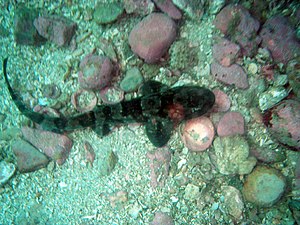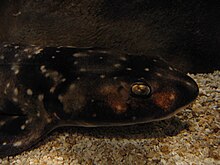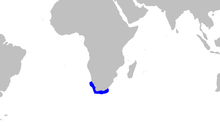Dark dogfish
| Dark dogfish | ||||||||||||
|---|---|---|---|---|---|---|---|---|---|---|---|---|

Dark dogfish ( Haploblepharus pictus ) |
||||||||||||
| Systematics | ||||||||||||
|
||||||||||||
| Scientific name | ||||||||||||
| Haploblepharus pictus | ||||||||||||
| ( Müller & Henle , 1838) |
The Dark dogfish ( Haploblepharus pictus ), known in English-speaking countries as "dark shyshark" or "pretty happy", is a kind from the family of dogfish (Scyliorhinidae), which is endemic in the moderate-warm waters off the coast of South Africa and the Southern Namibia lives. The bottom-living shark lives in flat coastal areas preferentially on sandy surfaces.
The sharks reach a body length of about 60 centimeters. It is compact and has a broad, flattened head with a rounded snout. It is equipped with seven darkly framed, brown saddle spots and large white spots. When threatened, like other species of the genus, it curls up into a ring and covers its eyes with its tail. It feeds mainly on smaller bony fish, crustaceans and molluscs.
features
The dark dogfish reaches a maximum length of about 60 centimeters and has a compact body with a short and wide head. The muzzle is flattened dorsally, compared to the puff adder dogfish , with which this shark is often confused, it is wider and more rounded. The back color is yellowish brown with scattered white spots and seven darker saddle spots, which, unlike the puff adder dogfish, are not darkly bordered. The ventral side is white. Individual individuals are very dark so that the drawing is only indistinctly or not at all recognizable.
The eyes are large and oval with a rudimentary nictitating membrane a prominent elevation below the eye. The nostrils are very large and in front each have a pair of greatly enlarged, triangular skin flaps that have grown together and extend to the mouth. A deep pit connects the outflow opening of the nostrils with the mouth, covered by the nasal lobes. The mouth opening is short and has furrows in the corners of the mouth. The teeth have a central point and two smaller side points.
The five gill slits are shifted to the top of the body. The dorsal, ventral and anal fins are roughly the same size. The dorsal fins start very far back on the body, with the first dorsal fin beginning above the last third of the ventral fin and the second dorsal fin above the anal fin. The pectoral fins are wide and also about the same size as the dorsal fins. The short and broad caudal fin is about one-fifth the length of the body and has a deep notch near the tip of the upper lobe and a barely developed lower lobe. The skin is thick and covered by heavily calcified, leaf-shaped placoid scales.
distribution and habitat
The distribution area of the dark cat shark is limited to the coastal area of southern Africa from Lüderitz in southern Namibia to East London in the Eastern Cape Province , South Africa . The area is largely separated from the range of the puff adder cat shark ( H. edwardsii ) with the exception of False Bay , South Africa, where both ranges overlap. In the Cape Town area the dark dogfish is rarer than the puff adder dogfish, while the density of individuals increases to the west and that of the puff adder dogfish decreases. According to the current state of knowledge, there is no overlap with the distribution area of the brown cat shark ( H. fuscus ).
The bottom-living shark occurs in the moderately warm coastal waters, especially in areas of the continental shelf at depths of up to about 35 meters with sandy, sometimes also stony soil in the area of reefs and kelp forests .
Way of life
The dark dogfish feeds mainly on bottom-dwelling crustaceans , bony fish and molluscs , with the proportion of crustaceans in the diet increasing with the age of the sharks. It also eats sea worms , echinoderms and other invertebrates.
The dark cat shark's predators are larger fish and sharks in its range, such as the broad-nosed seven-gill shark ( Notorynchus cepedianus ). Even marine mammals like living in the South African coastal South African fur seals ( Arctocephalus pusillus ) represent potential predators. When threatened or disrupting the Dark dogfish occupies a characteristic position in which he curls up and covered his eyes with his tail. It is believed that this way the shark is more difficult to swallow for a potential attacker. The known parasites of the dark cat shark include, for example, the single-cell Trypanosoma haploblephari , which belongs to the trypanosomes and can be detected in the shark's blood.
The dark dogfish is egg-laying ( oviparous ), whereby the females lay the eggs in pairs on vertical structures such as sea fans . Reproduction takes place throughout the year and there is no definable breeding season . The egg capsules are brownish and have a length of about 6 centimeters with a width of about 3 centimeters. The development time is about three and a half months before the young sharks hatch with a body length of about 11 centimeters. In captivity, it has been documented that the eggs of marine snails of the Buccinidae family , especially Burnupena papyracea and B. lagenaria , are eaten by eating the yolk.
The males reach sexual maturity after an estimated 15 years with a length of about 50 centimeters, females with a length of 49 centimeters.
Evolution and systematics
The dark dogfish was first described by the German biologists Johannes Müller and Jakob Henle as Scyllium pictum in 1838 in their systematic description of plagiostomes . The name was given according to the Latin pictum for "painted" due to the striking ornamentation of the shark. The shark was later transferred to the genus Haploblepharus , newly created by Samuel Garman in 1913 .
A molecular biological investigation based on three genes of the mitochondrial DNA revealed that the puff adder dogfish is the most original species of its genus. According to this study, the dark dogfish and the brown dogfish ( H. fuscus ) are sister species; the natal dogfish was not considered in this study.
| Haploblepharus |
|
||||||||||||
|
|
Relationship with people
The dark dogfish is harmless to humans and, due to its small size, is not of interest for commercial fishing, but is regularly caught and disposed of as bycatch . In addition, many of the sharks are caught by anglers from the shore and also killed and disposed of. A classification by the International Union for Conservation of Nature (IUCN) for this species is not available. The species is obviously not rare within its range. However, since this is very small and located in a heavily exploited area, an increase in fisheries or a decrease in habitats could have a potentially large effect on the overall population .
supporting documents
- ^ A b Heemstra, E. and P. Heemstra: Coastal Fishes of Southern Africa . NISC and SAIAB, 2004, ISBN 1920033017 , p. 67.
- ↑ a b c d e Compagno, LJV, M. Dando and S. Fowler: Sharks of the World . Princeton University Press, 2005, ISBN 9780691120720 , pp. 235-236.
- ↑ a b c Bester, C. Biological Profiles: Dark Shyshark . Florida Museum of Natural History Ichthyology Department. Retrieved on August 31, 2009.
- ↑ a b Dark Shyshark Haploblepharus pictus . Southern Underwater Research Group.
- ↑ a b c d e f Compagno, LJV: Sharks of the World: An Annotated and Illustrated Catalog of Shark Species Known to Date . Food and Agricultural Organization, Rome 1984, ISBN 92-5-101384-5 , p. 335.
- ↑ a b c Dainty, AM (2002). Biology and ecology of four catshark species in the southwestern Cape, South Africa. M.Sc. thesis, University of Cape Town.
- ↑ Ebert, DA: Diet of the seven gill shark Notorynchus cepedianus in the temperate coastal waters of southern Africa . In: South African Journal of Marine Science . 11, No. 1, December 1991, pp. 565-572.
- ^ Yeld, EM and NJ Smit: A new species of Trypanosoma (Kinetoplastida: Trypanosomatidae) infecting catsharks from South Africa . In: Journal of the Marine Biological Association of the United Kingdom . 86, No. 4, 2006, pp. 829-833.
- ↑ Smith, C. and C. Griffiths: Shark and skate egg-cases cast up on two South African beaches and their rates of hatching success or causes of death . In: South African Journal of Zoology . 32, 1997, pp. 112-117.
- ↑ Human, BA, EP Owen, LJV Compagno and EH Harley: Testing morphologically based phylogenetic theories within the cartilaginous fishes with molecular data, with special reference to the catshark family (Chondrichthyes; Scyliorhinidae) and the interrelationships within them . In: Molecular Phylogenetics and Evolution . 39, No. 2, May 2006, pp. 384-391. doi : 10.1016 / j.ympev.2005.09.009 . PMID 16293425 .
Web links
- Dark dogfish on Fishbase.org (English)
- Haploblepharus pictus in the Red List of Threatened Species of the IUCN 2013.1. Posted by: Human, B., 2008. Retrieved November 6, 2013.



